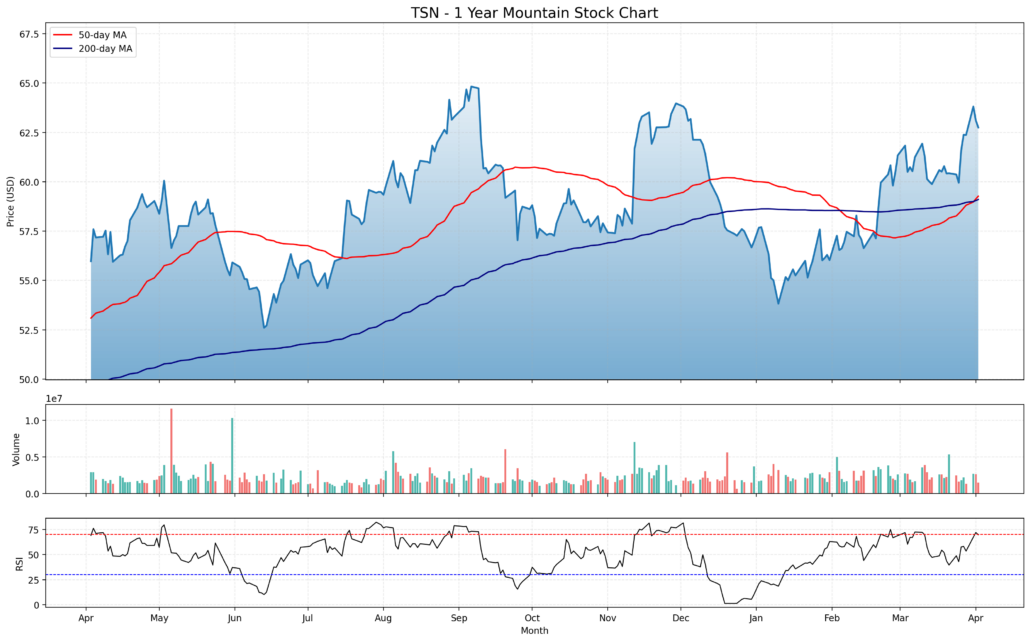Updated April 2025
Tyson Foods doesn’t need much introduction. If you’ve ever had chicken nuggets in your freezer or sausage links on a Sunday morning, you’ve likely had Tyson products on your plate. This company is one of the country’s largest meat processors, producing chicken, beef, and pork under household names like Hillshire Farm, Jimmy Dean, and Ball Park.
While it doesn’t make splashy headlines or sit atop growth investor watchlists, Tyson has quietly built a reputation for stability and scale. The business is deeply entrenched in the food supply chain, feeding not just households but restaurants and institutions too. And for income-focused investors, it’s been a steady player, consistently returning cash through dividends even when the broader market is on shaky ground.
Shares recently hovered around $62, with a 52-week range between $53.61 and $66.88. That kind of movement won’t excite day traders, but for dividend investors, it offers something better: predictability.
📌 Key Dividend Metrics
🧀 Forward Dividend Yield: 3.17%
💰 Annual Dividend Rate: $2.00
🔁 Payout Ratio: 66.55%
📈 5-Year Average Yield: 2.86%
🗓️ Next Ex-Dividend Date: May 30, 2025
💵 Dividend Growth: Modest but consistent
Recent Events
Over the last few quarters, Tyson has been navigating a pretty complex landscape. Rising feed costs, labor challenges, and shifting consumer preferences have kept management on their toes. But something changed recently: the numbers started to improve in a big way.
Revenue growth came in at 2.3% year over year, which doesn’t jump off the page. But earnings? They’ve soared. Quarterly earnings growth hit an eye-catching 235.5%. That’s a strong sign that Tyson’s efforts to cut costs and boost efficiency are gaining traction.
The company’s financial footing looks solid. With over $2.2 billion in cash and a current ratio of 2.11, liquidity is strong. Tyson is carrying a bit of debt—around $9.8 billion—but the debt-to-equity ratio of 52.64% is manageable, especially for a company of this size and scale.
Cash generation has also picked back up. Tyson posted $2.3 billion in operating cash flow and $1.13 billion in levered free cash flow over the trailing twelve months. For dividend investors, that last number matters most. Free cash flow is what supports those quarterly checks, and Tyson’s got it flowing again.
Dividend Overview
Tyson’s dividend story isn’t flashy, but it’s dependable. The stock is yielding 3.17%, which is higher than both its five-year average and what many large-cap consumer staples names are currently offering. It’s the kind of yield that adds meaningful income without taking on excessive risk.
The annualized dividend is $2.00, paid out quarterly. With the next ex-dividend date coming up in late May, there’s time for new investors to step in before the next distribution.
A 66.55% payout ratio suggests Tyson is keeping a solid chunk of earnings for reinvestment or balance sheet improvement, while still rewarding shareholders. It’s not overly aggressive, but it’s far from conservative. That middle ground should be comforting—enough yield to matter, with enough room for flexibility if earnings ever take a temporary dip.
This isn’t a company that suddenly surprises you with dividend hikes or buybacks. Instead, Tyson offers a steady hand. And in a market where volatility seems to be the norm, that kind of reliability has real value.
Dividend Growth and Safety
When it comes to dividend growth, Tyson plays it safe. In recent years, increases have generally landed in the 4% to 6% range annually. That may not knock your socks off, but for long-term investors, consistency often trumps size.
More importantly, Tyson didn’t slash or suspend its dividend even when margins got squeezed during inflation-heavy quarters. That’s a key marker of a company that takes its shareholder commitments seriously.
Looking at the numbers, Tyson’s dividend appears well-supported. The current payout is covered by earnings, and with EBITDA at $3.4 billion, there’s enough cushion built into operations. The enterprise value-to-EBITDA ratio sits around 9.14—not cheap, but also not stretched. That balance helps maintain dividend safety without limiting strategic flexibility.
Institutional investors clearly have confidence in Tyson’s long game, with more than 85% of the float held by institutions. That kind of backing tends to bring more discipline and long-term thinking, especially when it comes to capital returns.
Another feather in Tyson’s cap? Low volatility. A five-year beta of just 0.71 means this stock doesn’t swing wildly when the market panics. For dividend-focused investors, that calm demeanor adds another layer of comfort. You’re collecting a steady yield without riding a rollercoaster every quarter.
So while Tyson might not grab headlines, it’s quietly building a case as one of the more reliable dividend payers in the consumer staples space. It’s not about momentum—it’s about staying power. And TSN has shown it has plenty of that.
Cash Flow Statement
Tyson Foods has shown a rebound in its cash flow profile over the trailing 12 months, driven by a noticeable recovery in operations. The company generated $2.32 billion in operating cash flow, a strong improvement from the $1.75 billion seen in fiscal 2023. While still below the highs of previous years like 2021, this uptick suggests that the company is regaining control over its cost structure and cash generation. Free cash flow came in at $1.27 billion, comfortably covering dividends and leaving room for strategic reinvestment.

On the investing side, cash outflows moderated to $743 million, a drop from the heavier investment phase of 2023 and 2022. Tyson has also kept financing activity restrained, with $750 million in outflows, primarily tied to debt repayments and modest share repurchases. The company’s end cash position now stands at $2.31 billion—its highest since 2021—highlighting stronger liquidity and improved financial flexibility as it moves forward.
Analyst Ratings
📈 Piper Sandler recently shifted its stance on Tyson Foods (TSN), upgrading the stock from “Underweight” to “Neutral” in early February. The firm also updated its price target to $58. This move signals a more balanced outlook, reflecting an improved earnings profile and some stabilization in key segments like poultry.
🔄 Barclays maintained its “Overweight” rating but slightly adjusted its price target from $76 down to $75. While the reduction is marginal, it suggests analysts still see long-term potential, even if near-term challenges remain. The confidence appears rooted in Tyson’s ability to improve margin performance, especially in its core chicken business.
💬 As of early April, the overall analyst consensus is a “Hold” rating. Among 11 covering analysts, the average price target now stands at $61.10. That’s just slightly below the current share price around $62.75, hinting at a view that the stock is fairly valued at these levels.
📊 Much of the rating activity has been driven by Tyson’s better-than-expected quarterly results. Earnings per share came in at $1.14, well ahead of estimates, and revenues ticked up 2% to $13.6 billion. Notably, the chicken segment posted a 9.1% margin—almost double the prior level—indicating solid operational gains. At the same time, pressure in the beef segment and cautious consumer demand continue to temper expectations.
Analysts appear to be navigating a mixed bag: operational wins in poultry and strong free cash flow against lingering weakness in other proteins. The recent rating shifts reflect that balancing act.
Chart Analysis

Price Trend and Moving Averages
Over the past year, the price action for TSN has been a study in resilience. The stock began with a steep climb from its spring lows, pressing upward toward $60 by early summer, followed by several pullbacks that never quite broke the broader pattern of higher lows. The 200-day moving average (in dark blue) has steadily climbed throughout the period, confirming a longer-term upward bias. The 50-day moving average (in red) briefly rolled over during the late fall slump, but has since recovered and now converges with the 200-day line, a technically constructive development.
Recent price movement has pushed the stock back above both moving averages, which are starting to flatten and curl upward again. That kind of alignment often points to underlying strength and improved confidence in the name.
Volume and Market Participation
Volume has remained relatively consistent, though a few spikes—especially in mid-May and late October—stand out. These likely corresponded with earnings releases or other material updates. Importantly, the higher price surges in early March and late June were accompanied by solid volume, adding credibility to those upward moves.
In the most recent rally toward the $63 level, volume has been moderate—not euphoric, but supportive. That’s not a bad thing. It suggests the stock is moving higher without relying on aggressive speculative interest.
RSI Momentum
The Relative Strength Index (RSI) has hovered in the mid-to-upper 60s in recent weeks, with a few peaks brushing against the 70 mark. Those overbought signals haven’t led to major pullbacks, which may indicate continued demand and controlled buying rather than a euphoric spike. Earlier in the year, the RSI dipped into oversold territory around January, just before the stock began its recovery trend. That inflection point marked a shift in momentum that still appears to be playing out.
Right now, RSI is once again flirting with overbought levels, suggesting the rally might take a breather soon. But unless there’s a sharp divergence or breakdown in price, the chart still leans constructive.
Overall Structure
The chart tells a story of a stock that endured a tough stretch mid-year, found its footing, and is now pressing toward the upper end of its range with a more stable technical foundation. The upward-sloping 200-day average and improving RSI momentum paint a picture of recovery rather than euphoria. It’s not a breakout chart, but one that shows persistence, which matters when consistency and stability are key.
Earning Report Summary
Solid Start to the Fiscal Year
Tyson Foods opened its fiscal 2025 with a performance that showed some real momentum. Revenue came in at $13.62 billion for the first quarter, which was a decent bump—about 2.3% higher than the same quarter last year. What really helped was steady demand across its major protein categories, especially chicken and beef. Consumers may be price-conscious, but they’re still buying, and Tyson seems to be managing both pricing and volume fairly well.
The chicken business in particular showed some encouraging signs. Sales were up slightly to $4.07 billion, mostly due to a 1.5% increase in volume, even though prices dipped a little. Beef was even more impressive, pulling in $5.34 billion in sales—up more than 6% year-over-year. Volume rose, and pricing held steady. Pork did better than expected too, with higher prices offsetting a minor drop in volume.
Stronger Margins and Profit Growth
Where Tyson really surprised was on the profit side. Operating income jumped sharply, with the company reporting $580 million in GAAP operating income—a 151% increase. Adjusted operating income was even better at $659 million. EPS came in at $1.01, while adjusted EPS hit $1.14, both significantly above last year’s numbers. Margins also expanded, suggesting Tyson has better control over costs and pricing dynamics.
Even with all that, Tyson still has plenty of liquidity. The company finished the quarter with $4.5 billion on hand, giving it a good cushion for whatever lies ahead. Operating cash flow came in a bit lighter than the previous year at $1.03 billion, and free cash flow was $760 million—still solid, but down year-over-year.
Outlook Holding Steady
Tyson isn’t making any dramatic projections for the rest of the year, but they are adjusting their guidance with a bit more confidence. They now expect adjusted operating income to land somewhere between $1.9 billion and $2.3 billion for the full year. Revenue growth is expected to be flat or up slightly compared to last year, which seems realistic given current conditions.
They’re also planning to spend around $1 to $1.2 billion on capital projects, with a focus on profitability and maintenance. The tone coming out of this report felt measured but optimistic—Tyson knows where it’s strong and appears to be focused on keeping operations tight and efficient.
Management Team
Tyson Foods has made several leadership changes recently that reflect its intent to tighten operations and steer growth with experienced hands. Donnie King currently leads as President and CEO, bringing decades of industry knowledge and operational expertise. His leadership has been focused on restoring efficiency and strengthening the company’s position across global markets.
In August 2024, Curt Calaway was appointed Chief Financial Officer after serving as interim CFO. Having been with the company since 2006, Calaway has worked across several financial roles, which gives him a deep understanding of Tyson’s business structure and priorities. In early 2025, Devin Cole was promoted to Group President of Poultry, taking over from Wes Morris, who is retiring after assisting in a smooth transition. Brady Stewart also stepped into a broader leadership role during this period. These changes signal an emphasis on continuity, internal development, and maintaining experienced leadership during a time when operational execution is key.
Valuation and Stock Performance
Tyson’s stock has been trading around $62.75 per share in recent weeks. The price-to-earnings ratio is sitting at 63.7, which points to relatively high investor expectations. While it may seem stretched at first glance, the market is likely pricing in margin improvement and continued recovery across Tyson’s protein segments.
The 52-week trading range has been fairly tight, moving between $53.61 and $66.88. The stock hasn’t made any aggressive runs, but it’s been steadily climbing off its lows, reflecting a gradual shift in sentiment. Year-to-date performance shows a modest gain—steady enough to indicate market confidence without overheated enthusiasm.
Its price-to-book ratio of 1.21 suggests the market is placing a slight premium on the company’s assets, likely due to its brand strength and established market position. Valuation metrics are not screaming bargains, but they’re also not excessive for a company with this level of cash flow, consistency, and market dominance in food production.
Risks and Considerations
There are several risks worth paying attention to. Tyson is currently involved in legal proceedings, including an antitrust case that could impact its reputation and financials. These types of cases tend to move slowly, but their outcomes can influence how investors view long-term risk.
Labor remains another area of concern. The company relies heavily on immigrant labor in its plants, and any shifts in immigration policy or public scrutiny on working conditions could create additional pressure. Tyson has already had to close a facility in Kansas, affecting over 800 workers—an example of how the company is trying to streamline operations but also how vulnerable it can be to cost pressures and changing demand dynamics.
There are also environmental factors at play. Drought conditions have had an impact on cattle supply, which can throw off beef production and margins. And in poultry, the industry is still watching closely for how bird flu concerns are handled, especially with international export markets at stake. These are ongoing risks that can fluctuate season to season and require careful navigation.
Final Thoughts
Tyson Foods continues to prove it’s more than capable of navigating the ups and downs of a complicated supply chain and a shifting consumer landscape. The leadership team is clearly focused on tightening operations and prioritizing efficiency. Financial results are improving, and the stock’s performance, while not dramatic, has shown resilience.
There are risks here—legal, operational, and environmental—but they aren’t new to Tyson. This is a company that has weathered many cycles before and tends to find ways to adapt. For investors looking at long-term consistency and a business deeply embedded in daily consumer habits, Tyson still holds a strong seat at the table.

